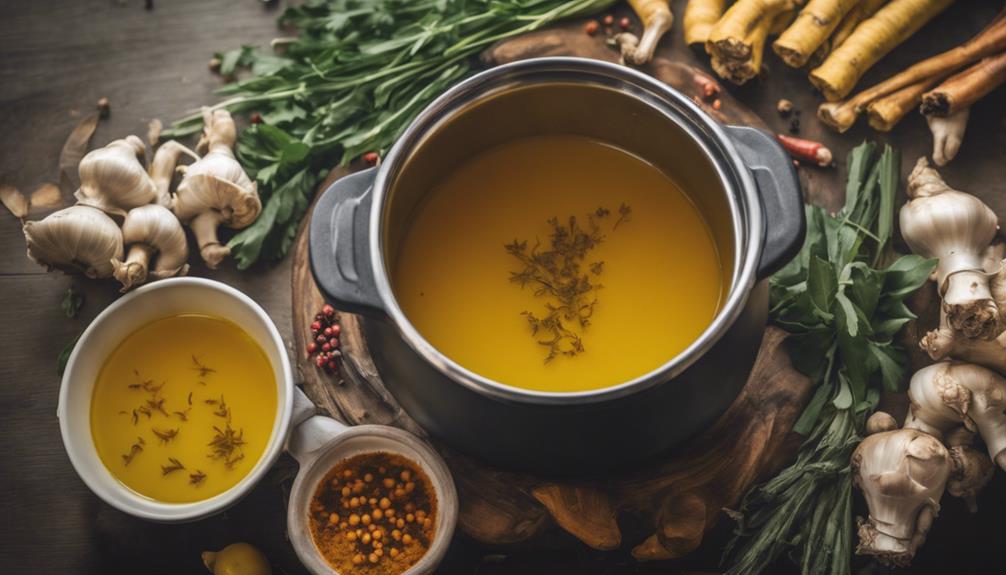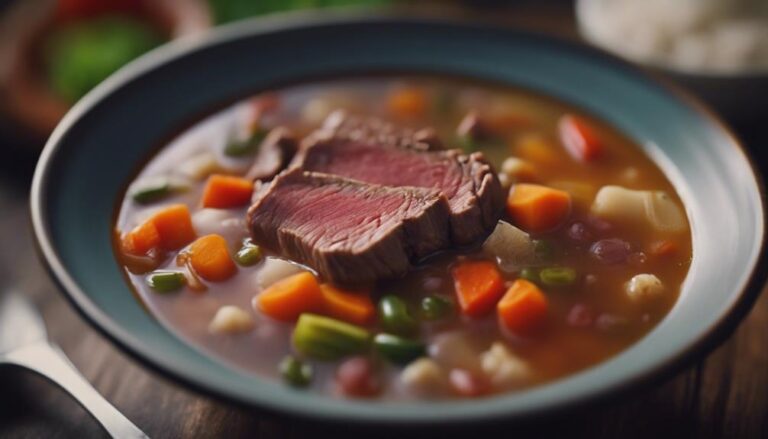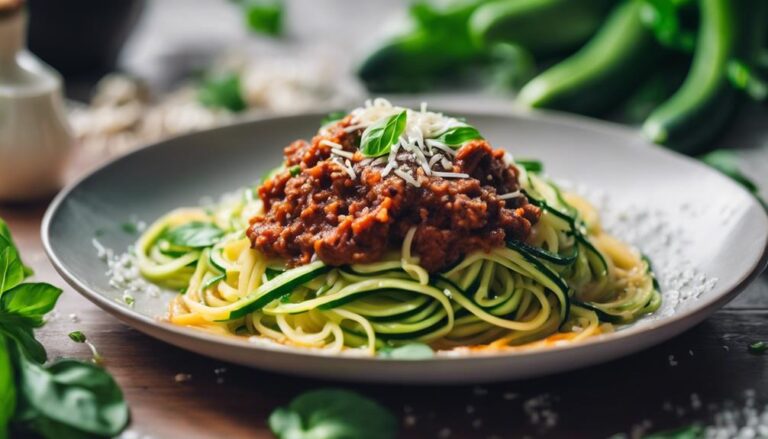Sous Vide Bone Broth With Turmeric
Enhance your broth-making skills by diving into the world of sous vide bone broth infused with turmeric. Seal your ingredients properly to maintain flavors. Control temperature precisely for best extraction. Let the collagen and minerals shine. Utilize turmeric for depth alongside other spices for balance. Achieve a well-rounded flavor profile with salt and acidity. Experiment with spice combinations to elevate your broth game. If you want to take your broth-making to the next level, explore the art of sous vide bone broth with turmeric for a rich, flavorful experience.
What You Will Learn Here
- Sous vide cooking extracts maximum nutrients from bones and turmeric.
- Precise temperature control ensures optimal flavor extraction and nutrient retention.
- Vacuum-sealing ingredients prevents dilution and maintains flavor concentration.
- Turmeric adds depth and anti-inflammatory benefits to the bone broth.
- High-quality ingredients and proper seasoning balance enhance the overall taste profile.
Broth-making in Ancient Times

Ancient times mark the origins of broth-making, revealing fascinating recipes and techniques passed down through generations. Understanding the historical context sheds light on the evolution of broth-making methods and the significance of this culinary tradition.
Ancient broths were crafted with care and precision, showcasing the ingenuity of our ancestors in creating nourishing and flavorful elixirs.
Historical Broth Origins
In early civilizations, the process of creating broth was a fundamental culinary practice rooted in the need to maximize the utility of food resources. Broth preservation methods varied across cultures and time periods, with techniques such as salting, simmering over low heat, and storing in cool spaces playing vital roles in extending the shelf life of broth.
The cultural significance of broth-making in ancient times can't be overstated, as it not only provided a way to extract nutrients from ingredients that might otherwise go to waste but also served as a communal activity, bringing people together around the hearth to share stories and sustenance.
Broth was a versatile and essential staple in many ancient societies, reflecting the resourcefulness and practicality of early culinary traditions.
Ancient Broth Recipes
Broth recipes from early civilizations showcased innovative methods of extracting nutrients and flavors from ingredients, highlighting the resourcefulness and practicality of ancient culinary traditions.
Ancient civilizations employed various broth preservation methods to guarantee longevity and availability of this nutritious elixir. Techniques such as simmering ingredients for extended periods, adding salt for preservation, and storing in cool environments were common practices. These methods not only enhanced the flavor profile but also contributed to the broth's health benefits.
Ancient broth recipes were revered for their ability to provide essential nutrients, promote gut health, and boost immunity. The meticulous attention to detail in crafting these broths reflected a deep understanding of the ingredients' properties and the desire to create nourishing and revitalizing concoctions.
Broth-Making Techniques Evolution
Evolve your understanding of early culinary practices by exploring the progressive techniques utilized in crafting nutrient-rich broths during ancient times.
In culinary history, broth making techniques have undergone significant evolution. In ancient times, boiling meat and bones in water was a common method to extract flavors and nutrients.
As civilizations advanced, the addition of herbs, spices, and vegetables enhanced the depth of flavors in these broths. Techniques like simmering for extended periods allowed for the extraction of collagen and minerals from bones, resulting in hearty and nourishing broths.
Ancient cooks also experimented with different cooking vessels and heat sources to control the temperature and achieve optimal extraction of flavors. Understanding these ancient broth-making techniques provides insight into the foundations of modern culinary practices.
Broth-Making Spices

Experimenting with different spices can enhance the flavor profile of your bone broth, elevating it to a new level of complexity and richness. To create aromatic broths that offer both flavorful combinations and health benefits, consider incorporating the following spices:
- Turmeric: Known for its vibrant color and earthy flavor, turmeric is a powerful immune-boosting spice. It contains curcumin, which has anti-inflammatory properties and adds an invigorating, slightly bitter taste to your broth.
- Ginger: Adding a spicy and zesty kick, ginger not only brings a revitalizing taste but also provides health benefits. It's believed to aid digestion, reduce nausea, and boost immunity, making it a great addition to your broth.
- Cinnamon: This sweet and woody spice can add depth to your broth. Cinnamon isn't only aromatic but also offers potential health benefits like helping to regulate blood sugar levels and providing antioxidants.
Incorporating these spices into your bone broth won't only enhance its flavor but also provide a range of health benefits.
Turmeric-Infused Broth Recipes
Let's explore the rich and aromatic world of turmeric-infused broth recipes.
Discover the warmth of a Golden Turmeric Broth, the comforting flavors of a Turmeric-Infused Chicken Broth, and the vibrant essence of a Turmeric-Spiced Vegetable Broth.
These recipes promise to elevate your broth-making experience with the powerful and earthy notes of turmeric.
Golden Turmeric Broth Recipe
When incorporating turmeric into your bone broth recipe, you can enhance its flavor profile and add a vibrant golden hue to your broth. Turmeric benefits your health with its anti-inflammatory properties and unique flavor.
Here's a simple golden turmeric broth recipe to try out:
- Ingredients:
- 4 pounds of bones (chicken, beef, or a mix)
- 2 tablespoons of turmeric powder
- 1 onion, chopped
- 2 carrots, chopped
- 2 celery stalks, chopped
- Salt and pepper to taste
- Instructions:
- Roast the bones in the oven.
- Place bones in a large pot, add water, turmeric, vegetables, salt, and pepper.
- Simmer on low heat for at least 12 hours.
- Enjoy your flavorful and nutritious golden turmeric broth!
Turmeric-Infused Chicken Broth Recipe
Enhance your culinary repertoire by infusing your chicken broth with the vibrant and health-boosting properties of turmeric.
- Turmeric Benefits
Turmeric is renowned for its anti-inflammatory and antioxidant properties, adding a nutritional boost to your chicken broth.
- Slow Cooking Techniques
To fully extract the flavors of turmeric and other ingredients, consider using slow cooking techniques like simmering the broth over low heat for an extended period.
- Flavor Infusion
When incorporating turmeric into your chicken broth recipe, allow the flavors to meld together by simmering the broth for an ideal time, ensuring a well-infused and flavorful result that not only tastes delicious but also provides the benefits of turmeric.
Turmeric-Spiced Vegetable Broth
Consider infusing your vegetable broth with the warm and earthy flavors of turmeric for a vibrant and aromatic twist on this classic recipe. Turmeric not only adds a pleasant color and taste but also brings a multitude of health benefits due to its anti-inflammatory properties and antioxidants.
Here are some key points to enhance your turmeric-spiced vegetable broth:
- Turmeric Benefits: Harness the anti-inflammatory and antioxidant properties of turmeric to boost the nutritional value of your vegetable broth.
- Flavor Profile: Turmeric adds a slightly peppery and warm flavor with a hint of bitterness, creating a unique depth in your broth.
- Vegetable Broth Variations, Health Benefits: Experiment with different vegetable combinations to tailor your broth to your liking while reaping the varied health benefits each ingredient brings.
Broth-Enhancing Seasoning Techniques
When enhancing your broth with seasonings, carefully select ingredients to complement the base flavors. Layering these seasonings effectively can create a depth of taste that elevates the overall broth profile.
Remember to balance saltiness and acidity for a harmonious and well-rounded broth experience.
Seasoning Selection Tips
To elevate the depth of flavor in your sous vide bone broth, carefully select complementary seasonings that will enhance its overall richness and complexity.
When considering seasoning preferences for bone broth, popular choices include bay leaves, peppercorns, garlic, and onions. These ingredients add layers of flavor that work harmoniously with the broth's richness.
Experiment with different flavor combinations such as thyme and rosemary for an earthy profile, or ginger and lemongrass for a more aromatic broth. Turmeric can enhance the broth with its warm, slightly bitter notes and vibrant color.
Remember to balance the flavors by tasting as you season, ensuring that each addition contributes positively to the overall taste profile of your bone broth.
Layering Flavors Effectively
Layer flavors effectively in your sous vide bone broth by strategically employing various broth-enhancing seasoning techniques to enhance its overall depth and complexity. When enhancing the taste profiles of your bone broth, consider flavor pairing to create a harmonious blend of tastes. Here are some techniques to help you achieve this:
| Flavor Pairing | Examples |
|---|---|
| Sweet & Savory | Honey & Soy Sauce |
| Spicy & Tangy | Chili & Lime |
| Herbaceous & Earthy | Rosemary & Mushroom |
| Umami & Smoky | Soy Sauce & Smoked Paprika |
| Citrusy & Herbal | Lemon & Thyme |
Balancing Salt and Acidity
To achieve a well-balanced sous vide bone broth with turmeric, it's essential to carefully adjust the levels of salt and acidity in your broth, ensuring a harmonious blend of flavors. Balancing the salt content is vital to prevent the broth from becoming overly salty. Start by adding a moderate amount of salt, then taste and adjust as needed throughout the cooking process.
Additionally, acidity levels play a significant role in enhancing the overall taste profile of the broth. Ingredients like vinegar or citrus juices can help brighten the flavors and balance the richness of the broth. Experiment with small increments of acidity, tasting as you go, to achieve the perfect balance that complements the earthy notes of turmeric in your sous vide bone broth.
Final Thoughts
In conclusion, consider incorporating a variety of herbs and spices for additional depth of flavor in your sous vide bone broth with turmeric. Not only does this enhance the taste profile, but it also contributes to the nutritional benefits of the broth. Turmeric, a key ingredient, contains curcumin, known for its anti-inflammatory properties and potential health benefits. When preparing your bone broth sous vide, remember to balance the salt and acidity levels to achieve the desired taste. Additionally, using fresh, high-quality ingredients will enhance the overall quality of your broth.
Cooking tips for sous vide bone broth include ensuring that the ingredients are properly vacuum-sealed to prevent any liquid from entering the bags during the cooking process. This helps maintain the concentration of flavors and nutrients. Moreover, controlling the temperature precisely during the sous vide cooking process is essential for extracting all the beneficial compounds from the bones and spices. By following these suggestions, you can create a delicious and nutrient-rich bone broth with turmeric using the sous vide technique.
Frequently Asked Questions
Can Bone Broth Be Made With Alternative Animal Bones?
Yes, bone broth can be made with alternative animal bones such as chicken, turkey, or fish. These sources offer various nutritional benefits like collagen, amino acids, and minerals, contributing to overall health and well-being.
How Can I Store Bone Broth for Optimal Freshness?
To store bone broth for best freshness, refrigerate it promptly. It lasts 3-4 days in the fridge. For longer storage, freeze it. Use airtight containers or freezer bags, leaving space for expansion. Thaw in the fridge.
Are There Any Vegetarian Alternatives to Bone Broth?
For a plant-based alternative to bone broth, consider making vegetable broth using ingredients like carrots, onions, and celery. This option provides similar nutritional benefits and can be a flavorful substitute in various recipes.
Can Bone Broth Be Frozen for Long-Term Storage?
Yes, bone broth can be frozen for long-term storage. Freezing benefits include preserving its nutrients and extending its shelf life. To maintain quality, store in airtight containers or freezer bags, leaving room for expansion.
What Are the Potential Health Benefits of Turmeric-Infused Broth?
Turmeric-infused broth offers anti-inflammatory properties, immune-boosting benefits, supports gut health, and provides joint support. The active compound, curcumin, in turmeric aids in reducing inflammation and promoting overall wellness.
Conclusion
To sum up, sous vide bone broth with turmeric offers a modern twist on ancient broth-making traditions. By infusing the broth with turmeric, you not only add depth of flavor but also benefit from its anti-inflammatory properties.
Experiment with different spices and seasonings to enhance the taste and health benefits of your broth. With the sous vide cooking method, you can easily achieve a rich, flavorful broth that's both nutritious and delicious.











